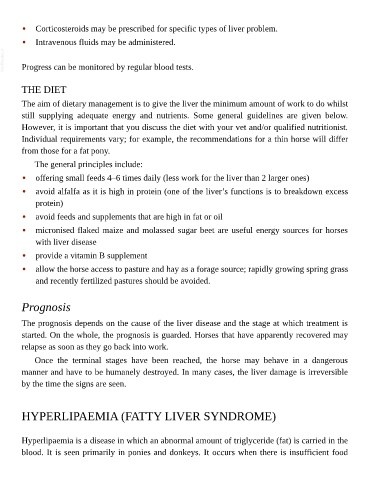Page 791 - The Veterinary Care of the Horse
P. 791
• Corticosteroids may be prescribed for specific types of liver problem.
• Intravenous fluids may be administered.
VetBooks.ir Progress can be monitored by regular blood tests.
THE DIET
The aim of dietary management is to give the liver the minimum amount of work to do whilst
still supplying adequate energy and nutrients. Some general guidelines are given below.
However, it is important that you discuss the diet with your vet and/or qualified nutritionist.
Individual requirements vary; for example, the recommendations for a thin horse will differ
from those for a fat pony.
The general principles include:
• offering small feeds 4–6 times daily (less work for the liver than 2 larger ones)
• avoid alfalfa as it is high in protein (one of the liver’s functions is to breakdown excess
protein)
• avoid feeds and supplements that are high in fat or oil
• micronised flaked maize and molassed sugar beet are useful energy sources for horses
with liver disease
• provide a vitamin B supplement
• allow the horse access to pasture and hay as a forage source; rapidly growing spring grass
and recently fertilized pastures should be avoided.
Prognosis
The prognosis depends on the cause of the liver disease and the stage at which treatment is
started. On the whole, the prognosis is guarded. Horses that have apparently recovered may
relapse as soon as they go back into work.
Once the terminal stages have been reached, the horse may behave in a dangerous
manner and have to be humanely destroyed. In many cases, the liver damage is irreversible
by the time the signs are seen.
HYPERLIPAEMIA (FATTY LIVER SYNDROME)
Hyperlipaemia is a disease in which an abnormal amount of triglyceride (fat) is carried in the
blood. It is seen primarily in ponies and donkeys. It occurs when there is insufficient food

